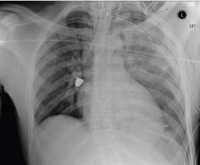-
At least 26 dead after worst mass shooting in Texas history at San Antonio-area church
A lone gunman killed at least 26 people and injured many more at a church in Sutherland Springs. The tiny town was left reeling from the deadliest shooting at a place of worship in American history. The victims ranged in age from 5 to 72. The gunman has since been identified as 26-year old Devin Patrick Kelley. Kelley served in the Air Force and was court-martialed in 2012 for assaulting his spouse and their child. He received a bad conduct discharge, 12 months’ confinement, and a reduction in rank.
-
-
Is gun violence contagious? The answer is mostly “no”
Is gun violence contagious? According to new research, the answer is mostly no. Rather, this violence is a chronic issue for particular neighborhoods and requires place-specific solutions. “It’s been known for some time that gun violence, like many other forms of crime and other social problems, can be clustered within certain neighborhoods,” says one researcher. “So when we observe that a particular part of the city has an elevated risk, how do we understand what that phenomenon actually is?”
-
-
Severity of firearm injuries increased over the past 20 years

New research presented today at American Public Health Association’s (APHA) 2017 Annual Meeting and Expo revealed that the severity of firearm injuries has increased over the past twenty years, among those hospitalized for their injuries. Researchers noted that their findings have broad implications for public health beyond increased suffering on the individual level.
-
-
Nuclear energy programs do not increase likelihood of nuclear weapons proliferation: Study

Contrary to popular thought, nuclear proliferation is not more likely to occur among countries with nuclear energy programs, according to new research. In a historical analysis of the relationship between nuclear energy programs and proliferation from 1954 to 2000, the study finds that the link between the two has been overstated. “The findings suggest that international efforts to manage the proliferation risks of nuclear energy programs have been quite effective,” says the study’s author. “Even when countries become more technically capable of developing nuclear weapons due to an energy program, they can often be restrained by timely intelligence and the prospect of sanctions.”
-
-
Improving public safety during severe weather, other disasters
Our ability to observe and predict severe weather events and other disasters has improved markedly over recent decades, yet this progress does not always translate into similar advances in the systems used in such circumstances to protect lives. A more cohesive alert and warning system that integrates public and private communications mechanisms and adopts new technologies quickly is needed to deliver critical information during emergency situations. At the same time, better understanding of social and behavioral factors would improve the ways we communicate about hazards, inform response decisions such as evacuations, develop more resilient urban infrastructure, and take other steps to improve weather readiness.
-
-
As wildfires expand, fire science needs to keep up
In the month of October nearly 250,000 acres, more than 8,000 homes and over 40 people fell victim to fast-moving wildfires in Northern California, the deadliest and one of the costliest outbreaks in state history. Now is the time to wrestle with hard questions. Why did communities that were deemed safe suffer major damage? Should they be rebuilt in the same way? Are there better ways to fight extreme fires and limit their impact? How can emergency planners prepare better for scenarios where full evacuation is not possible? Fire conditions are constantly evolving, and basic research coupled with engineering solutions must keep up. Designing more resilient communities and infrastructure and protecting people more effectively are not onetime goals – they are constant. Currently nations are failing to meet the challenge, and impacts on communities are increasing.
-
-
Protecting major sport venues
Three major sporting leagues — the National Football League (NFL), Major League Baseball (MLB), and National Basketball League (NBA) — have played a key role in significantly upgrading and strengthening security at stadiums and arenas throughout the country with the help of the Department of Homeland Security Science and Technology Directorate’s SAFETY Act. The Support Anti-Terrorism by Fostering Effective Technologies (SAFETY) Act incentivizes private sector investment in protecting the nation’s critical infrastructure and the public by providing liability risk mitigation and litigation tools for claims that stem from or relate to an act of terrorism where a SAFETY Act covered technology (called a qualified anti-terrorism technology) is used.
-
-
Real security requires strong encryption – even if investigators get blocked
The FBI and the U.S. Department of Justice have been fighting against easy, widespread public access to encryption technologies for 25 years. Since the bureau’s dispute with Apple in 2016 over access to the encrypted iPhone of one of the two people who shot 14 victims in San Bernardino, California, this battle has become more pitched. This dispute is not about whether regular people can or should use encryption: The U.S. government is in favor of using encryption to secure data. Rather, it’s about the FBI’s demand that encryption systems include “exceptional access,” enabling police who get a warrant to circumvent the encryption on a device or on an encrypted call. The demand for exceptional access by law enforcement is a broad threat to fundamental parts of American society, and it poses a serious danger to national security as well as individual privacy. As technology changes, the jobs of police and intelligence workers must also change; in some ways, it will be harder, in others, easier. But the basic need for security supports the call for wide use of strong encryption – and without modifications that make it easy for Russians, or others, to break in.
-
-
Fire-resistant coating to prevent failure in steel building fires
A few extra coats of “paint” could be all that the steel in a building needs to prevent itself from buckling and failing in a fire. Scientists came up with this idea when they were figuring out a commercially viable solution to protect reinforced concrete against underground fires. After two years of intensive research and development by the interdisciplinary team, an affordable 3-in-1 coating that offers enhanced fire and corrosion protection was invented.
-
-
The Devil’s puzzle: Defining international and domestic terrorism
It’s becoming a familiar scene. A vehicle becomes a weapon of terror. This time in New York City, where a driver in a rental truck suddenly careened down a bike and pedestrian path on the west side of the city on Tuesday, killing at least eight and injuring more than ten people. New York officials say it was an act of terror, and the incident is likely to reignite the debate on what constitutes domestic and international terrorism and whether it matters. An argument can be made that distinguishing between what constitutes an act of terrorism and what doesn’t still provide significant value.
-
-
200 killed in tunnel collapse at North Korea nuclear test site
About 200 North Korean laborers and engineers have been killed after a mine shaft being dug at the country’s nuclear test site collapsed in early September. On 3 September, North Korea conducted a nuclear test of a bomb with a yield of about 280 kilotons (the Hiroshima and Nagasaki bombs were in the 12-15 kiloton range). Experts say that the powerful test, conducted in a neighboring tunnel, may have weakened the wall- and ceiling-support scaffolding of the tunnel which collapsed. North Korea has conducted all its nuclear tests in a tunnel network under Mount Mantap. South Korean and Chinese scientists have warned that the mountain may be suffering from “Tired mountain syndrome,” and that more tests may cause the mountain to collapse, releasing large amounts of radioactive fallout.
-
-
Israel demolishes Gaza tunnel, killing 9 Palestinian militants
The Israel military (IDF) on Monday morning destroyed a tunnel Hamas fighters were building under the Israel-Gaza Strip. The Hamas Health Ministry in Gaza said that nine Palestinians were killed and eight others were wounded when the IDF blew up the tunnel. Israel this summer began work on an underground barrier meant to counter attack tunnels.
-
-
Wildfire early warning system could prevent spring blazes
Researchers have developed a new early warning system to predict when and where human-caused wildfires are most likely to occur in the spring. Using satellite images of vegetation, the researchers can forecast where wildfire risk peaks in boreal forests by tracking moisture in fuel sources like leaves.
-
-
EU set to define cyberattacks as “acts of war,” allowing collective military response
In Response to Russian interference in the electoral campaigns in Germany, France, and the Netherlands, and the North Korean WannaCry attack on the U.K. health services, EU governments are planning to sign a declaration – officially titled “The framework on a joint EU diplomatic response to malicious cyber activities” — which defines cyberattacks on any EU country as an act of war, potentially triggering a military retaliation – even including conventional arms – in response. The proposed EU declaration would be similar to a change NATO made to the treaty governing NATO operations: In 2014, NATO updated its cyber defense policy, to make an explicit link between cyberattacks at a certain threshold and the invocation of a NATO’s article 5 collective defense as part of the treaty.
-
-
Assad regime behind April 2017 sarin attack on Sunni civilians: UN
A new report, released Thursday by the Organization for the Prohibition of Chemical Weapons (OPCW), the UN chemical weapons watchdog, has found that the forces of Syrian President Bashar al-Assad were behind the deadly chemical weapons attack which killed more than ninety people in the village of Khan Sheikhoun on 4 April 2017. The Syrian regime’s use of chemical weapons against Sunni civilian triggered a U.S. retaliation – fifty-nine Tomahawk cruise-missiles launched against the airbase from which the planes carrying the chemicals took off for the mission.
-
More headlines
The long view
Factories First: Winning the Drone War Before It Starts
Wars are won by factories before they are won on the battlefield,Martin C. Feldmann writes, noting that the United States lacks the manufacturing depth for the coming drone age. Rectifying this situation “will take far more than procurement tweaks,” Feldmann writes. “It demands a national-level, wartime-scale industrial mobilization.”
How Male Grievance Fuels Radicalization and Extremist Violence
Social extremism is evolving in reach and form. While traditional racial supremacy ideologies remain, contemporary movements are now often fueled by something more personal and emotionally resonant: male grievance.
The Surprising Reasons Floods and Other Disasters Are Deadlier at Night
It’s not just that it’s dark and people are asleep. Urban sprawl, confirmation bias, and other factors can play a role.
Why Flash Flood Warnings Will Continue to Go Unheeded
Experts say local education and community support are key to conveying risk.
